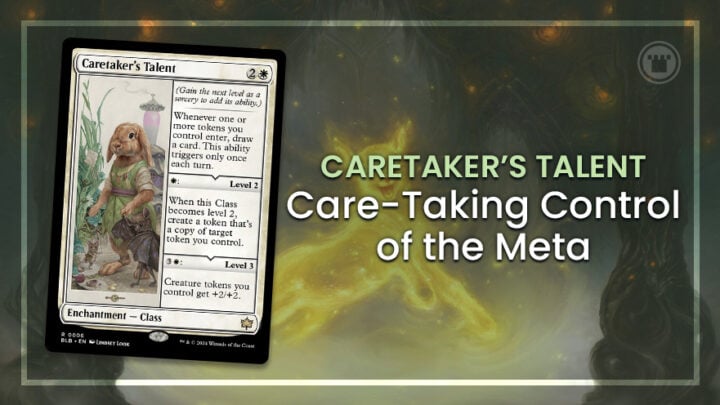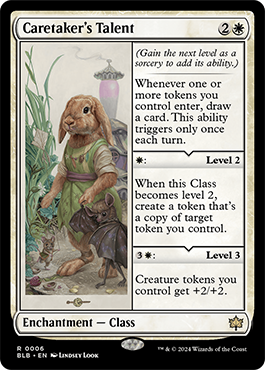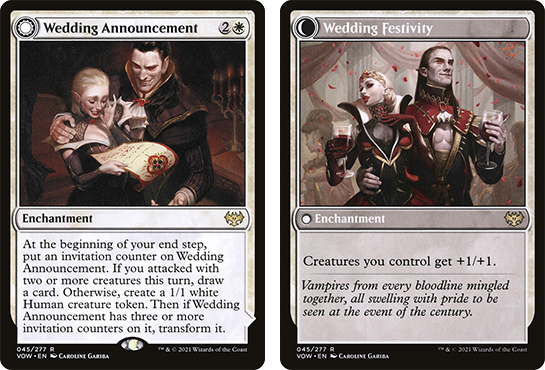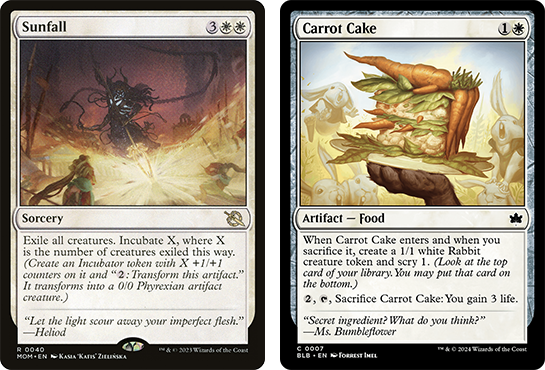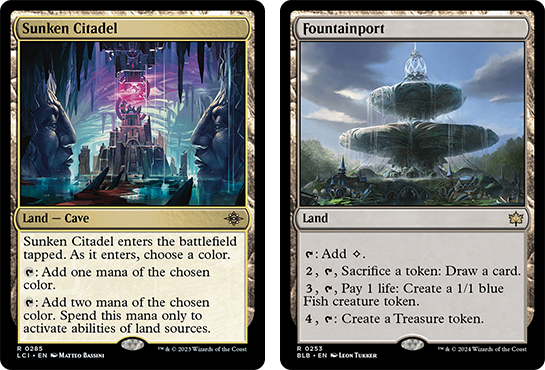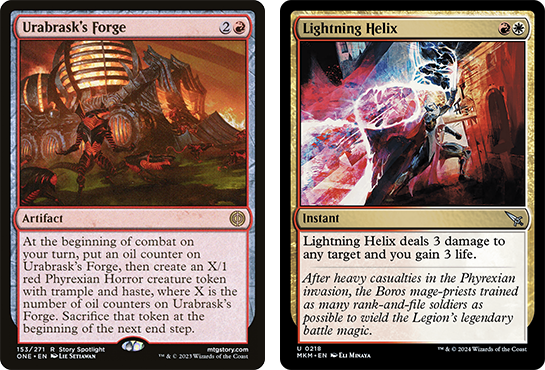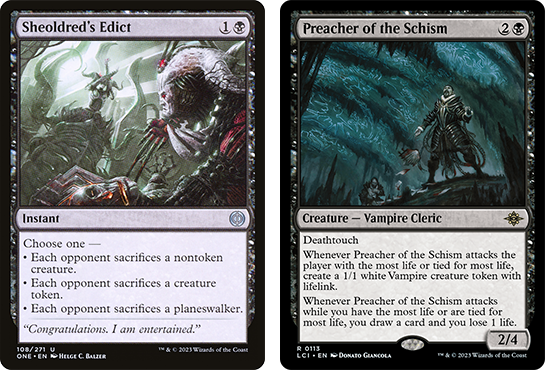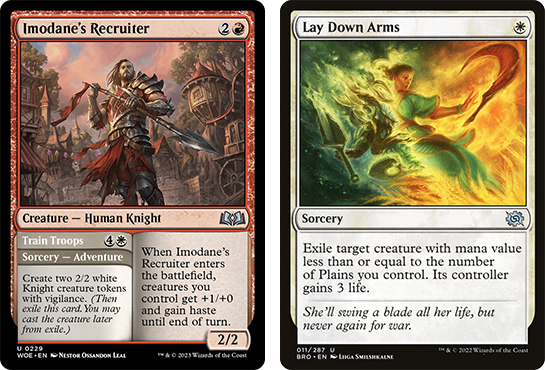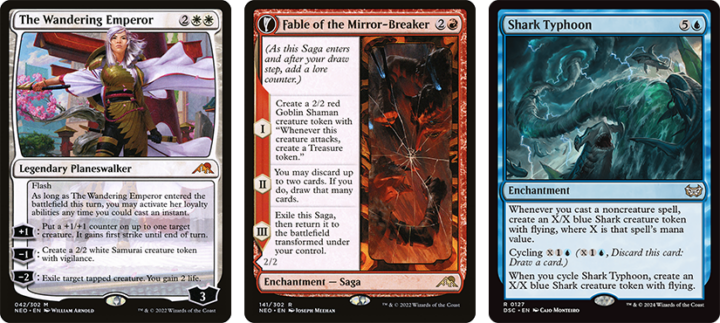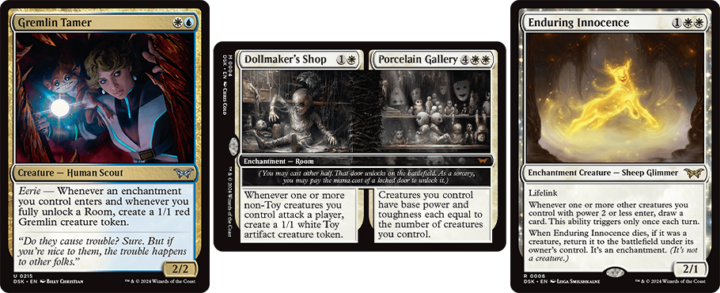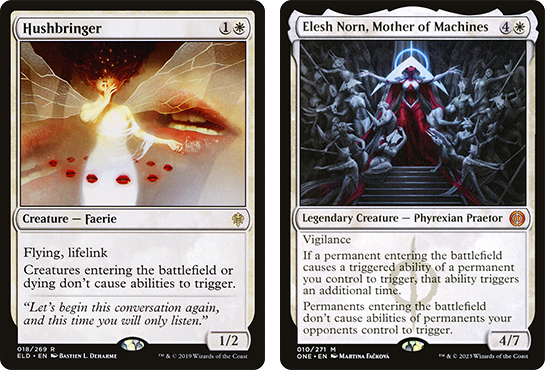Caretaker’s Talent has been taking hold in multiple formats, becoming a cornerstone of multiple decks that Tom dives deep into here!
The cycle of rare Talents have been frontrunners for Bloomburrow’s best constructed cards right out of the blocks. In the first week after the set released, I wrote about a string of upstart Standard decks that were already emerging around these multi-faceted enchantments. Innkeeper’s Talent was immediately ubiquitous across midrange decks, Bandit’s Talent pushed heavy discard strategies into the meta, while Scavenger’s and Artist’s Talents have made inroads into older formats.
But as the meta has matured through the release of Duskmourn: House of Horror, one Talent in particular has proven so powerful as to completely distort the color pie and balance of Constructed. This card has already driven traditional control decks to near-extinction in Standard, is making heavy inroads into Pioneer, and seems to only be gathering momentum.
And yes – it is the one with the cute little bunny on it.
CUTE, BUT DEADLY
As we’re used to seeing from rares in the Commander-forward design era, Caretaker’s Talent clearly has a dazzlingly high ceiling. Who can remember the days when card draw was virtually forbidden on white cards?
The level one ability alone has consistently ranked as somewhere between “solid sideboard tech” and “format staple” on cards like Welcoming Vampire, Tocasia’s Welcome, and Wedding Announcement. But the question with this card (at least initially) concerned its floor. All the Talents need a little setup to get rolling, but Caretaker’s does literally nothing until you can create some tokens: you can’t even sink mana into leveling it up, since missing the level 2 trigger is unforgivable in most situations.
Looking back at those previous draw engines, the reason Wedding Announcement stood head and shoulders above the others is because it could flex between creating tokens and drawing cards depending on the situation, with no reliance on synergy or mana investment.
Elevating Caretaker’s Talent to that level of consistency seemed like it would sacrifice too much in deckbuilding to be worthwhile. In a meta defined by punishingly fast tempo decks, how often can a control player afford to swap out the best-available spell in a slot for its less-efficient cousin that nets a token? But that question turns out to have been far less relevant than anticipated – simply because in most cases the token-making spells are already the best effects in their class, turning a potential vulnerability into pure upside for the Caretaker’s decks.
For example, Sunfall has become a go-to sweeper even at five mana specifically because it gives you a lead in board presence rather than resetting to neutral. If you still need a cheaper option, No Witnesses does the job and still nets a clue. Beza, the Bounding Spring is the best anti-aggro card in Standard and might just be white’s best card overall.
Other token-makers may not qualify as format all-stars, but have proven so cheap and efficient that they never seem to slow the deck down. Carrot Cake is reminiscent of Thraben Inspector: a self-replacing body that does just enough to stall aggro decks without losing equity in other matchups. In fact, it’s proven so good in this role that you could be forgiven for forgetting the format also contains an actual reprint of Thraben Inspector!
But arguably the most important enabler for Caretaker Control as an archetype has been the combination of Sunken Citadel and Fountainport.
Citadel has been quietly revelatory across most Constructed formats, unlocking the hidden potential of various utility lands and contributing valuable color fixing with very little drawback. Fountainport is a reasonable control card in its own right, flexibly combining the chump-blocker generation of a Castle Ardenvale with a self-contained backup draw engine.
But with Sunken Citadel around to further elevate its efficiency, Caretaker Control can afford to max out on copies of this versatile ETB-untapped land while still running the usual Citadel package of Demolition Field and creature-lands. It all adds up to an impressive amount of token generation while barely giving up any power at all. But then the opponent starts casting spells, and Caretaker’s Talent actually gets even better again!
Get Lost is the most efficient and flexible spot removal in the format, maindecked and sideboarded by virtually every deck with access to white mana. Not only does the Caretaker’s trigger make Get Lost significantly less rewarding for opponents to cast, it even unlocks the situational bonus play of targeting your own permanent to draw cards off the Talent!
Any of the Bloomburrow gift effects are likewise dicey when cast into the (buck)teeth of this Talent. Temporary Lockdown might wipe the current board of tokens, but other permanents like Carrot Cake can be released with a well-timed Get Lost, leading to new tokens on ETB and even more draws from our build-around enchantment. Even exiling the Talent itself with an effect like Leyline Binding can be dangerous, since breaking it out allows the Caretaker player to re-trigger the level 2 token-cloning ability.
Seeing so many top-tier cards positioned perfectly to enable this Talent – even those cast by your opponent – we can really start to understand why this single enchantment has led to a predominantly white archetype becoming Standard’s leading control deck for the past two sets.
TOKEN REPRESENTATION
I have to say “predominantly white” there, because at this point there have been successful experiments with Caretaker Control variants in at least four different color combinations – and I feel like we’re ripe for a green-white list ramping into Awaken the Woods and Progenitor Exarch any day now.
Most of us think of UW as synonymous with control decks, but prior to Duskmourn, both WB and WR lists were significantly more prominent. WR in particular seemed to be the dominant composition: the efficient spot removal of Torch the Tower and Lightning Helix proved essential for a deck which often wants to siphon off mana for activating lands or leveling Talents during the midgame. Urabrask’s Forge is another massive addition to the main or side, sporting perhaps the best two-card synergy with Caretaker’s Talent alongside Fountainport.
WB couldn’t quite match that card quality, but made up for it with a range of valuable anti-meta tech options. Sheoldred’s Edict plays around Snakeskin Veil and similar effects out of the tempo decks, while Anoint with Affliction and Legions to Ashes counteract a lot of nasty death triggers and graveyard-based synergies.
Duress and Soul Search let you be proactive in noncreature matchups rather than trying to simply brute force them with a Talent draw. And there are still some solid token generators like Preacher of the Schism, Aclazotz and Kaya, Spirits’ Justice.
Since the release of Duskmourn we’re now seeing a lot more momentum coalesce behind a virtually mono-white version of Caretaker Control. Playing one color (with a tiny sideboard splash for Imodane’s Recruiter off Sunken Citadel and surveil lands) means you can get greedy with the nonbasic land package around Sunken Citadel and STILL play a set of Lay Down Arms – a spell which combines many benefits of both the WR and WB removal suites!
Obviously you could already do this prior to Duskmourn, but it’s the addition of new white bombs like Enduring Innocence and Overlord of the Mistmoors which has helped close the gap in card quality compared to two-color versions and pushed this build over the top.
TAKING CARE OF BUSINESS
But perhaps the biggest new development for this nascent archetype has been its shockingly successful transition into Pioneer contention! Both the RW and WB versions of Caretaker Control seemed to make the leap to the much more powerful format with basically no change in philosophy, which is a strong indicator that this is no mere flash in the metagame pan!
Just swap in a few S-tier token-makers like The Wandering Emperor, Fable of the Mirror-Breaker, and Wedding Announcement where it makes sense on the curve, add March of Otherworldly Light to leverage your excess card draw and update the sideboards – your novel little Standard deck is now finishing in the prize money at major qualifiers and 500-seat SCG events!
Even more exciting are the finishes posted by more experimental decklists. The token-centric deckbuilding of RW Caretaker makes it easy to incorporate an Indomitable Creativity combo package, which is already seeing widespread adoption. Access to stronger synergy pieces like Shark Typhoon and Yorion, Sky Nomad are encouraging Pioneer players to revisit possible UW versions of the deck – or at least to try and find room for the signature enchantment in their existing control lists.
However, the build that really grabbed my attention was one that Odon Neto used to reach Top 32 of a 212-player tournament in Brazil. Neto was all-in on Duskmourn cards: not only running the more commonplace Enduring Innocence and Overlord of the Mistmoors, but also Sheltered by Ghosts, Dollmaker’s Shop // Porcelain Gallery and a full playset of Gremlin Tamer!
In fact, if you look closely at this list you’ll realize it’s very close to being Standard-legal, despite UW Caretaker being totally overlooked in that format! One result alone may not be proof of anything, but I don’t see why subbing the handful of Wandering Emperors and Wedding Announcements for extra copies of those Duskmourn cards wouldn’t give you a recipe for equivalent Standard success!
TIME FOR A TALENT SEARCH
Given the rate we see new set releases these days and the sheer density of pushed spells within those sets, it’s remarkable to see a single enchantment do so much to reshape the metagame landscape – let alone have those changes seemingly stick for the mid-to-long term.
At this point I am fairly confident in predicting the Caretaker archetype is here to stay, at least as an equal competitor to other ways of building control decks. Yes, the Constructed metagame is always subject to sudden reversals, especially when a single deck or key card gets too popular. But Caretaker’s Talent has already been around long enough for those adjustments to manifest, and what we’ve seen has been a lot more weighted towards “join them” than “beat them”.
When you think about it, the deck doesn’t really offer up any massive vulnerabilities for deckbuilders to attack, even after sideboarding: you can bring in extra interaction for the Talent itself, perhaps an ETB-canceling effect like Hushbringer or Elesh Norn, Mother of Machines, but it’s more or less fair Magic.
For my money, this Caretaker revolution is basically all positive: I love decks which commit heavily to playing around permanents, especially dinky little white cards like Carrot Cake. I would certainly argue that a world where control decks are focused on spot removal and trading tokens in combat is far more interesting than one where they play around one-card instant wins like Atraxa, Ugin, Emergent Ultimatum, Alrund’s Epiphany, and suchlike.
If nothing else, the arrival of a build-around this potent is a premier opportunity for any brewers and jank-lovers among us to dig up a bunch of old also-ran token spells, just to see if any other archetypes could potentially benefit from a token-themed makeover. The Great Caretaker’s Talent Search is only just beginning…

Tom’s fate was sealed in 7th grade when his friend lent him a pile of commons to play Magic. He quickly picked up Boros and Orzhov decks in Ravnica block and has remained a staunch white magician ever since. A fan of all Constructed formats, he enjoys studying the history of the tournament meta. He specializes in midrange decks, especially Death & Taxes and Martyr Proc. One day, he swears he will win an MCQ with Evershrike. Ask him how at @AWanderingBard, or watch him stream Magic at twitch.tv/TheWanderingBard.

